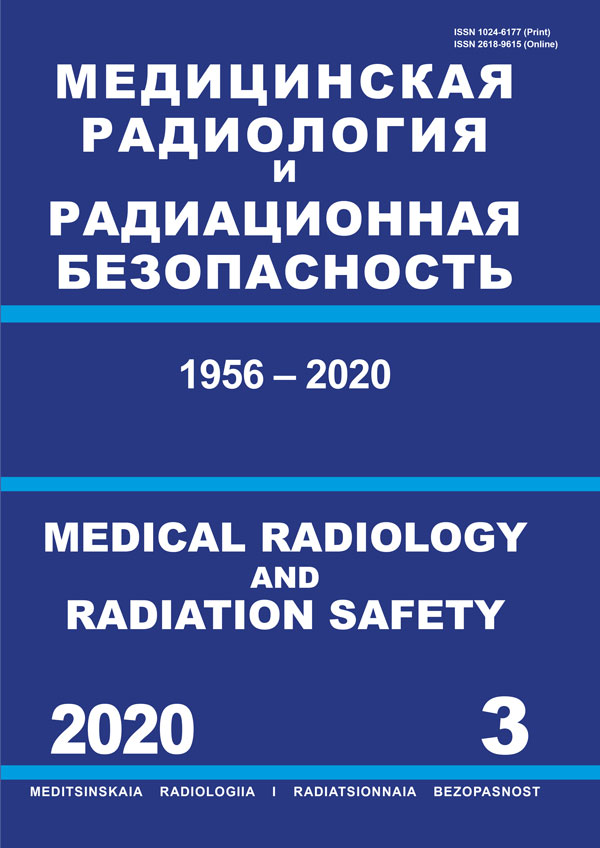CSCSTI 34.49
Purpose: To compare radiation responses of yeast and mammalian cells to combined actions of various agents and on this basis to draw a conclusion about the possibility of synergy ideas application in medical radiology. Material and methods: The yeast cells of Saccharomyces cerevisiae were exposed to the combined action of hyperthermia (22–58 °C, exposure time 0–9 hrs) with ionizing radiation (25 MeV bremsstrahlung 5 and 25 Gy/min or γ-rays 60Co, 2, 10, and 80 Gy/min, acute irradiation) or anti-tumor drug cisplatin (0,05 or 0,25 mg/ml, exposure time 0–3 hrs). The result of synergistic interaction for yeast cells was assessed by the survival curves obtained by the authors after separate exposure to hyperthermia, ionizing radiation, cisplatin and after combined action of hyperthermia with ionizing radiation or cisplatin. To quantify the synergistic interaction of similar combined actions on mammalian cells, the data published by other authors have been used who did not evaluate the synergistic effect themselves. Results: The synergistic interaction of hyperthermia with ionizing radiation or cisplatin was established for yeast and mammalian cells. It is shown that the synergistic effect of the simultaneous action of these agents is observed only within a certain temperature range, within which there is an optimal temperature at which the greatest synergism occurs. This optimal temperature is shifted to lower values with a decrease in the dose rate of ionizing radiation or concentration of cisplatin. For sequential application of hyperthermia and ionizing radiation the effect of combined action increases with an increase in acting temperature up to a certain limit, after which it remains constant. These results are interpreted using the mathematical models previously proposed, in accordance with which the synergism is determined by the formation of additional damage due to the interaction of sub-damage that are not effective after separate application of agents. Despite the fact that all of the data presented were obtained at temperatures far beyond the ambient temperature, it is not excluded that there could be optimal intensities of harmful agents existing in the biosphere and capable of interacting with physiological heat of animals and man in a synergistic manner. Hence, the assessment of health or environmental risks from numerous natural and man-made agents at the level of intensities found in environmental and occupational settings should take into account synergistic interaction between harmful agents. Conclusion: The general regularities of synergistic effects of combined action of hyperthermia with ionizing radiation or with cisplatin for yeast and mammalian cells have been established – the existence of optimal parameters for acting agents providing the highest synergy and its dependence on the intensity of agents applied.
ionizing radiation, hyperthermia, cysplatin, combined actions, synergism, optimization, yeast, mammalian cells
Повышение эффективности применения комбинированного воздействия ионизирующего излучения с другими агентами является актуальным для медицинской радиологии, стерилизации медоборудования, пищевых продуктов и т.д. Большое распространение в лучевой терапии получило использование ионизирующих излучений с гипертермией и химическими радиосенсибилизаторами. Продемонстрировано синергическое взаимодействие исследуемых агентов, когда их эффект превышает сумму независимых эффектов от их раздельного применения. Одной из распространенных точек зрения на механизм синергизма является подавление способности клеток восстанавливаться от радиационных повреждений. Однако на экспериментальных данных было показано, что при комбинированных экспозициях процесс восстановления клеток от потенциально летальных повреждений не нарушается, а наблюдавшееся ингибирование восстановления обусловлено образованием дополнительных необратимых повреждений за счет взаимодействия некоторых субповреждений, не эффективных при раздельном применении агентов. На этой основе были предложены математические модели синергизма, позволяющие оптимизировать параметры воздействующих агентов для достижения максимального синергизма и объясняющие его зависимости от интенсивности используемых факторов.





